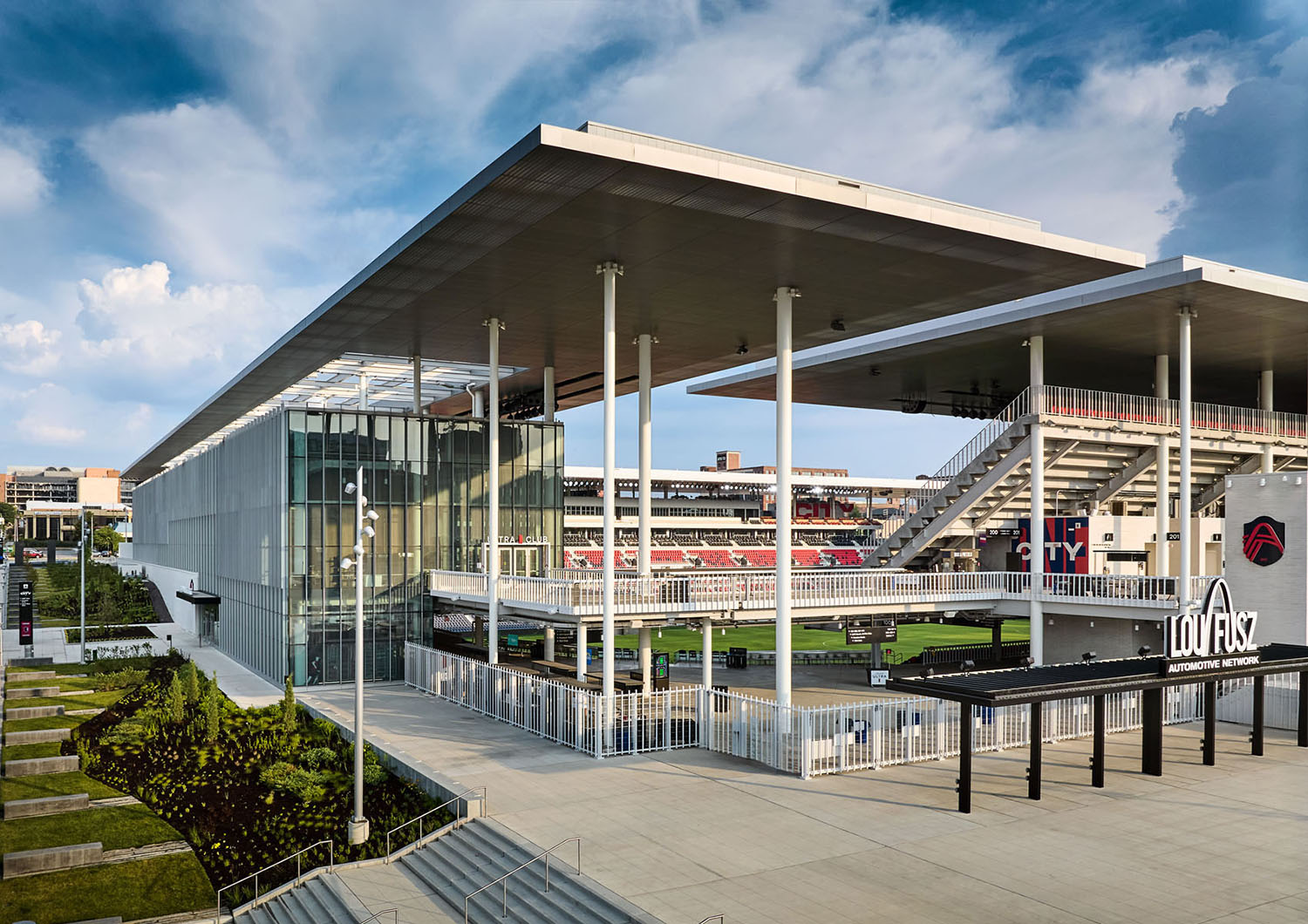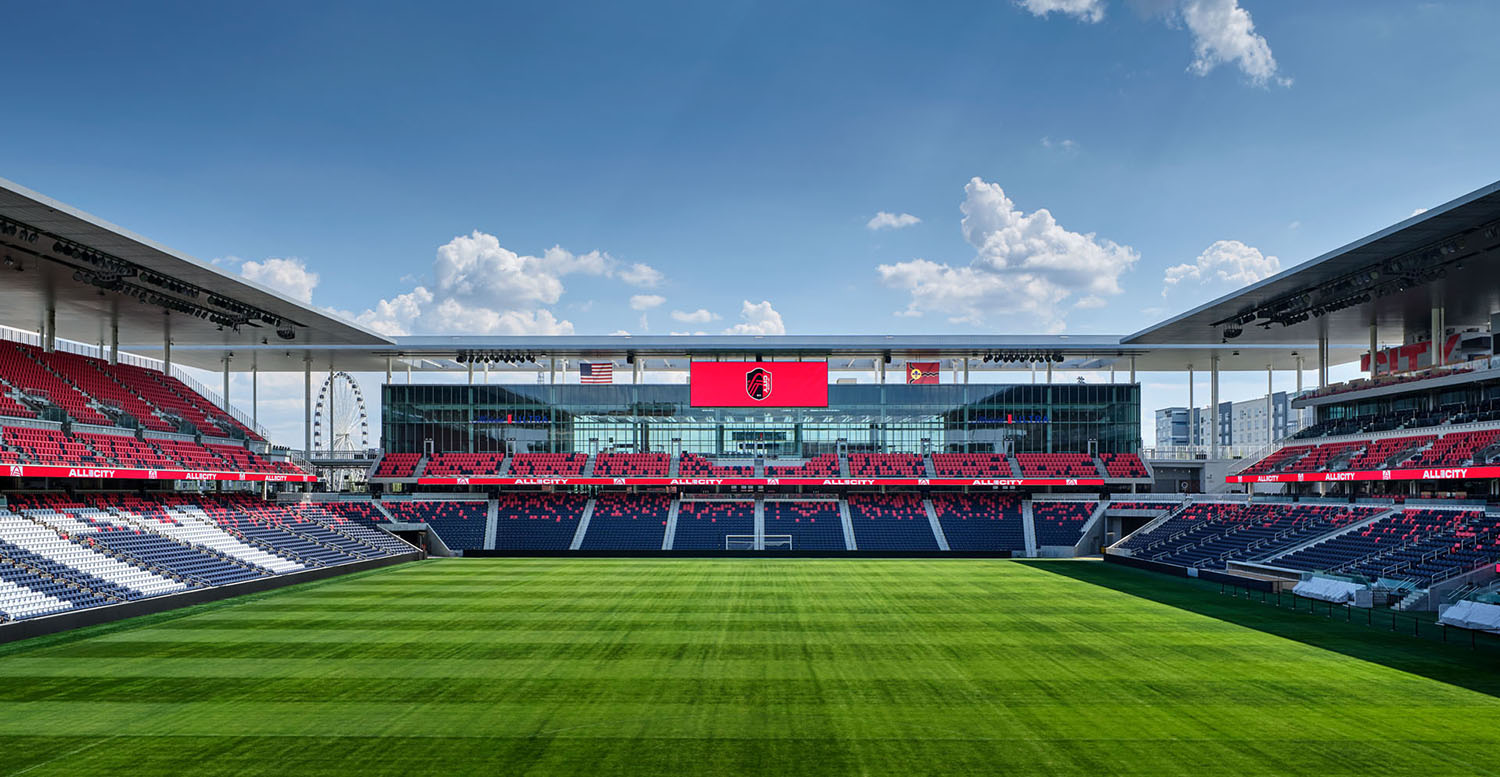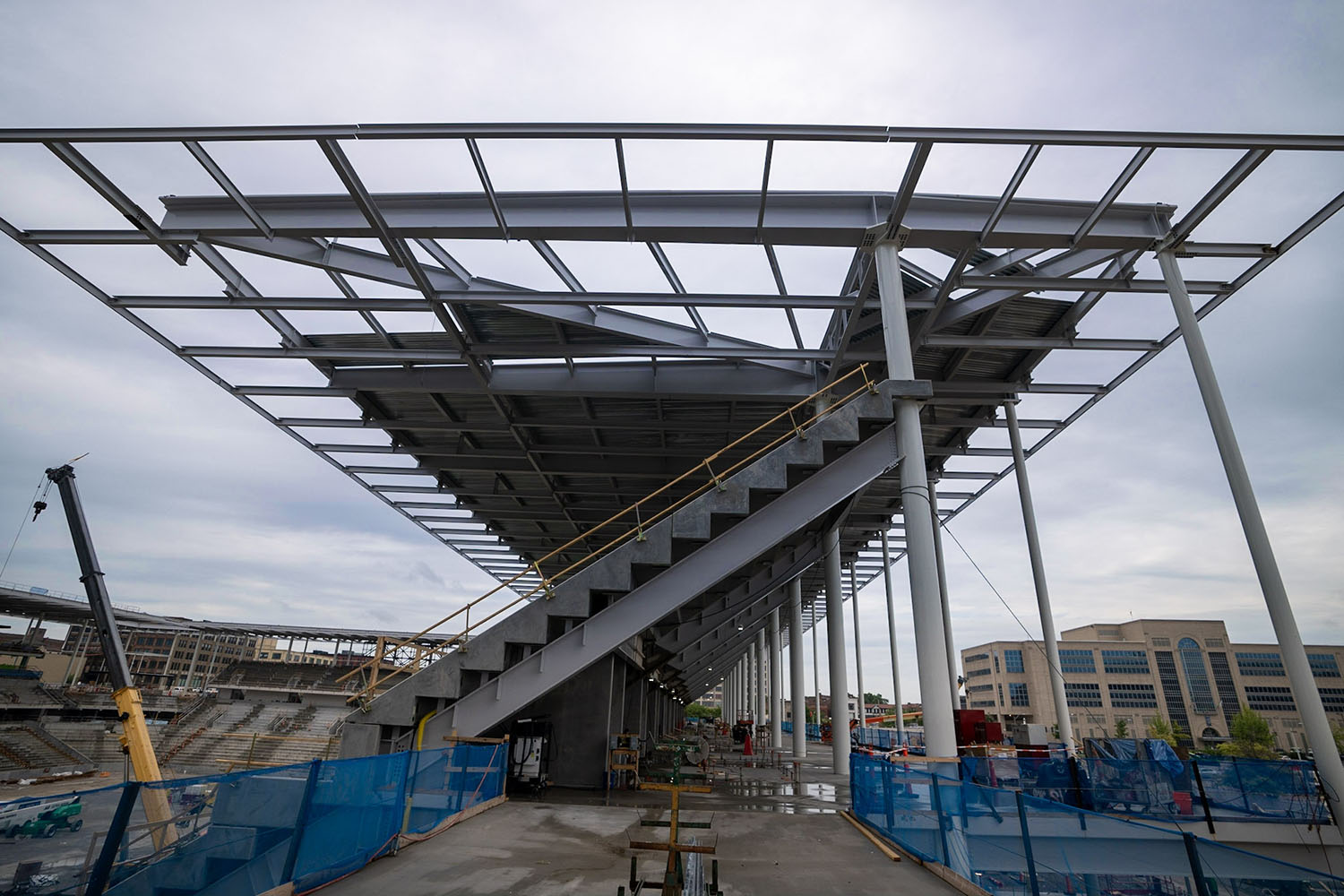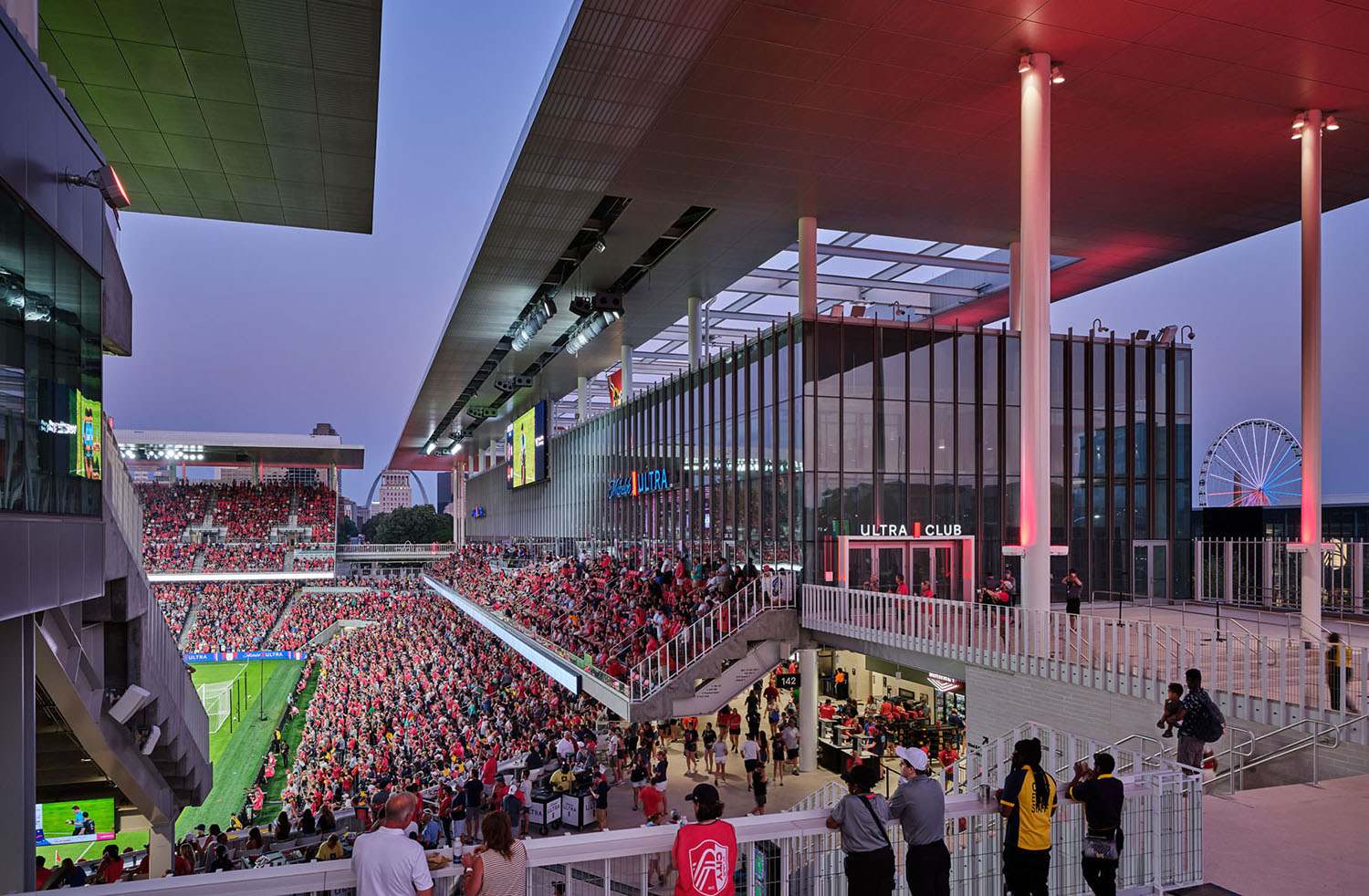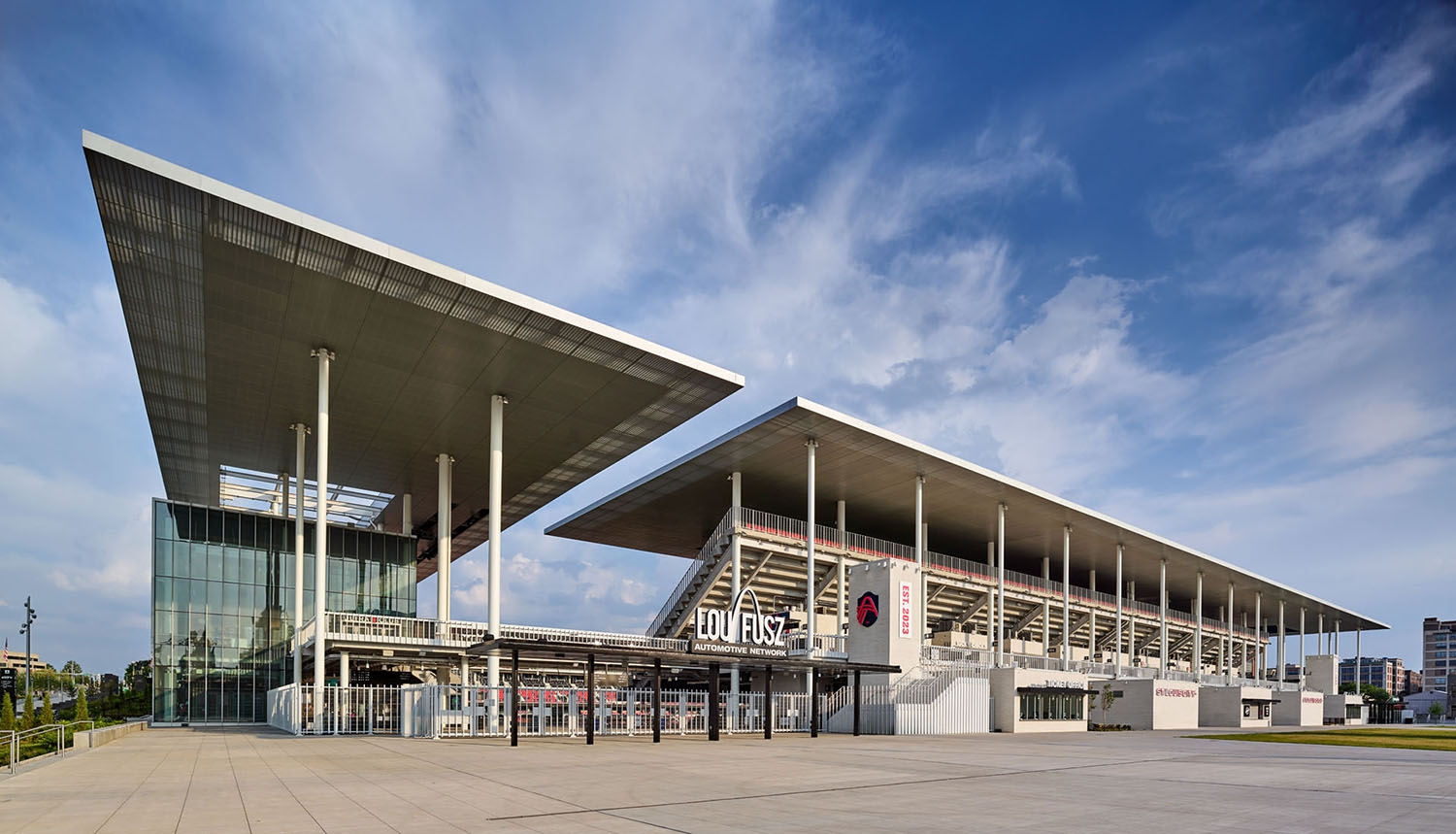AISC
CITYPARK
Excellence in Architecture
"It looks extremely efficient with its sharp edges on the roof, thin columns, and long cantilevers. It's sleek and unadorned. We're always impressed with how thin you can make something in a steel solution." -- Larry Rickels, PE, Principal, Datum Engineers, 2024 IDEAS² Awards Judge
The owners of St. Louis CITY SC, a new Major League Soccer franchise in St. Louis, envisioned more than a stadium when considering their club’s future home venue. They aimed to create a vibrant mixed-use stadium district in the city’s Downtown West neighborhood that impacted the area beyond game days.
Their vision birthed 22,500-seat CITYPARK, designed to fit comfortably into its urban neighborhood. The stadium is across the street from historic Union Station and at the end of the Gateway Mall, linking the stadium to the Gateway Arch and Mississippi River through a stretch of green and public spaces. Its compact, transparent form allows views into the pitch from surrounding streets and views of the city from the seating bowl. The main concourse aligns with the west end of the Gateway Mall, extending the urban fabric into the stadium.
The stadium exterior features glass, metal panels, and stone walls. Open concourses promote movement and social spaces, with ground-floor retail and gathering spaces further integrating the venue into the neighborhood. All four sides of the stadium are open and inclusive, welcoming fans from every direction. The stadium corners’ openness serves a dual purpose: draw people together during games and create flexible plazas for non-gameday community events. Both align with the vision of enhancing Downtown West.
The design features a flat portico, cut-out corners, and slender columns framing the upper seating bowl. A flat canopy was fabricated from material that reflects light similarly to the Gateway Arch. The canopy, spanning 120 ft with a 25-ft backspan, protects fans from the elements while letting in daylight, amplifying fan noise, and creating a sense of enclosure to focus attention onto the field. The seating bowl is 40 ft below street level, ensuring no seat is more than 120 ft from the pitch.
The southern portion of the stadium, which extends from the Gateway Mall, is slightly detached from the northern structure, acknowledging its position opposite the Gateway Arch by providing enhanced views from premium seating areas.
CITYPARK exhibits a seamless fusion of structural engineering and architectural design. The design reflects the stadium’s urban surroundings and prioritizes openness by inviting the neighborhood inside. The structural engineering complements the architecture with a coordinated system that features steel throughout, creating open, interconnected spaces and fluid exterior forms.
The coordinated structural approach dramatically reduces lateral framing to allow transparency, opens corners to reveal the urban setting, and extends the steel canopy outward to link the stadium to the neighborhood visually. The interplay of engineering and architecture transforms the stadium into a new landmark for downtown St. Louis.
Structural steel met the architectural goal of creating an open and transparent structure with streamlined gravity and lateral systems while ensuring expedited fabrication and erection. Steel framing with slender columns and discreet braces allows the lateral system to disappear, avoiding the imposition of perimeter-braced frames that would obstruct views. Steel trusses and girders enable long canopy spans while keeping structural depth minimal for a thin, lightweight aesthetic.
Steel connections were precisely engineered to eliminate stiffeners and optimize the slender column designs. Steel’s lightness reduced foundation loads on the variable rock profiles. CITYPARK was also designed to utilize 100% recycled structural steel. The structural components are designed for easy disassembly and reassembly, allowing for adaptive reuse and reducing environmental impact.
The steel framework comprises trusses spanning to primary tapered girders supporting the canopy roof structure, with steel girders and open web joists at retail and concession levels. Custom connections were designed in close coordination with the architectural team. Integrating lightweight spanning trusses and girders balanced aesthetic aspirations with structural requirements.
Design Decisions
CITYPARK’s innovative design and construction addressed complex site conditions while integrating structural and architectural design objectives.
The Downtown West site presented numerous challenges, including intricate rock contours, access constraints, varying perimeter retaining wall conditions, and high seismic design parameters. The stadium’s foundation is engineered to adapt to the diverse geotechnical conditions of the site, comprising spread footings, friction piles, and mat foundations. Using steel to reduce the structural self-weight was key to optimizing the foundation strategy.
Using perimeter-braced frames would have detracted from the design intent of a sleek, transparent structure with maximum openness to the surrounding area. The design team, in response, wanted to make the lateral system effectively disappear. Three pieces helped them achieve their goal: Designing the feature columns to act as frames, relying on the rigidity of the seating bowl, and integrating discreet braced frames at the base.
That approach effectively concealed the lateral system within the stadium’s structure. The arrangement optimized functional efficiency within the aesthetic framework, further contributing to the stadium’s open and streamlined appearance.
The engineering team designed all structural connections to accelerate the schedule and achieve constructability and aesthetic considerations. At critical and repetitive conditions, finite element modeling enabled optimization of design performance, material reductions, and cost savings. All three modeling benefits allowed precise calibration of structural behavior and enhanced the design and construction team’s ability to tackle problems quickly.
In one case, on the eve of the mill order issuance, the team learned that the feature interior hollow structural section (HSS) 24-in. columns would not be available in 5⁄8-in. wall thickness for several months. The final wind tunnel test results were not yet available, creating risk of reducing wall thickness to an unconservative degree.
The design team quickly developed a detail that would strengthen the HSS columns at their peak demand locations, if the final wind tunnel results required it. The fast analysis, collaboration, steel connection, and fabrication flexibility helped maintain the schedule. Ultimately, the strengthening detail was not required.
Close collaboration between the design and steel fabrication teams from conception through construction facilitated mutual understanding and ensured a smooth transition from design to construction, including accelerated submittal review. The teams worked collaboratively through the complexity of the connection details, including fabricated mockups of multiple weld details to ensure the final product met client expectations. The teams also coordinated the timing of mill orders to ensure that the appropriate shapes were available when needed.
Complex Canopy
The canopy and its primary supporting columns--two defining features of the stadium--underwent three major design iterations to arrive at an optimal tapered steel plate girder system that aligned with the architectural vision of a thin look while adhering to budget and constructability considerations. An outrigger system enhances the shallow cantilevered appearance along the entire canopy interior and exterior perimeters, adding to the stadium’s aesthetic.
Initially, the team examined a constant depth built-up plate girder system. Cost concerns necessitated a second analysis to economize the design and explore a tapered truss system that used less material. The numerous connections in the second design option increased costs, though, despite the material savings.
A subsequent design iteration led to the final canopy girder design: a tapered built-up plate girder system where the bottom of the girder maintains a constant elevation and the top slopes. The 1½-in.-thick flange plates vary in width along the entire length of the beam, with the overall girder depth ranging from 3 ft at the ends to 6 ft at the center. Outriggers at each canopy end are typically 14 in. deep and 15 ft long, adhering to the desired light and thin appearance.
The canopy projects outward from the seating bowl perimeter, bringing diffused daylight into the stadium. Its steel framework, with slender columns spaced at 25 ft by 36 ft typically, supports metal panels defined by the architectural form. Discreet bracing and minimal pipe columns enhance transparency.
The canopy’s stability is provided through a combination of steel moment frames and the rigid precast seating bowl, which also aids in efficient load distribution as part of the diaphragm system. While the canopy roof shape is uniform on all four sides, the supporting conditions below vary substantially due to differing program spaces and required close collaboration to locate braced frames in discreet locations throughout the concourses and back-of-house areas.
The final design of girder-to-column connections included a bolted connection of the girder to the cap plate over the column, eliminating the need for additional stiffeners in the column. The largest columns, HSS24, are placed along the fulcrum, with HSS16 along the exterior side of the stadium and back support of the canopy.
Corner canopy openings extend the inviting nature of the stadium beyond match days by creating flexible community gathering areas. This collaborative and iterative design process between architectural vision and engineering practicality resulted in community-centric architecture, integrating the canopy with the stadium’s overall structural and aesthetic narrative.
Constructability Friendly
CITYPARK’s loading dock introduces an uncommon approach to the stadium service area. A tunnel on the south side allows services to enter the stadium below grade, eliminating the typical back-of-house services area at street level.
The team designed the loading dock as an open, column-free space to maximize operational efficiency. A full-height concrete truss supports the tunnel lid for service entry below grade, and a parallel steel truss structure supports the stadium and plaza above. Built-up plate girders, approximately 73 ft long and 4 ft deep, transfer column loads and support sections of the elevated structure. The combination of concrete, steel, and plate girder systems enabled an obstruction-free loading dock space.
Detailing the interface between concrete and steel structures required close coordination, demonstrating an integrated design approach for architectural openness and practical utility.
The corporate constructability program implemented by the Mortenson, Alberici, L. Keeley joint venture (MAK JV) introduced early contractor engagement, which reduced material lead times by expediting the design process and improving design efficiencies.
A notable feature was MAK JV’s self-perform and fabricating capabilities covering steel fabrication, steel erection, precast erection, earthworks, and underground utilities, giving MAK JV better control over the project’s schedule. MAK JV could store materials on its corporate sites until they were required, streamlining operations and ensuring materials were available when needed.
Constructability reviews began before the construction phase. The construction team engaged with HOK designers to discuss material selection and procurement during the schematic design phase. In the design development phase, MAK JV and HOK refined steel shape selections based on the extended lead times exacerbated by the COVID-19 pandemic.
Members of the MAK JV self-perform team collaborated with the designers during the constructability review, which was key in manufacturing the required shapes and sizes of structural steel and selecting connection types to keep the project on schedule. The team’s value engineering exercises helped lock in prices and meet the long lead times associated with materials and equipment procurement.
The design team and MAK JV implemented Procore, Tekla, and Solibri for constructability reviews throughout the project, and also implemented lean principles, such as pull planning, to address the schedule and the construction sequence. Internal coordination for steel fabrication, steel erection, and precast erection, along with progressive 4D schedule modeling, benefited the project schedule.
Self-performance of all the initial construction activities allowed MAK JV to start strong, work through issues with minimal impacts by resequencing, and collaborate with the design team for efficient solutions.
Initially, project specifications called for an architecturally exposed structural steel (AESS) designation. However, close coordination with the design team and the owner allowed MAK JV to understand the owner’s true design intent and build mockups. After viewing the mockups, the owners realized they could achieve the desired look without AESS and for less cost.
MAK JV also ensured quality by closely coordinating with precast fabricators, especially during long lead times. That quality assurance process included having an employee on-site for a month for quality control. The constant communication and collaboration with subcontractors also contributed to the project’s success.
CITYPARK exemplifies the expertise and dedication of the project team and CITY SC’s commitment to the region. The stadium has left a lasting impact on St. Louis and its residents, who have embraced CITYPARK and the club wholeheartedly. Investment has poured into Downtown West, with approximately $820 million in development and 300 new occupancy permits issued. The stadium and team have become engines of St. Louis’ revival.
General contractor: Mortenson | Alberici | Keeley (MAK JV), St. Louis
Architect and structural engineer: HOK, St. Louis
Architect: Snow Kreilich Architects, Minneapolis
Associate structural engineer: David Mason + Associates, St. Louis
Fabricator: Hillsdale Fabricators, St. Louis *AISC full member; AISC-Certified fabricator*
- Location: St. Louis, MO
- Submitting Firm: HOK
- Photo Credit: 1, 2, 5, 6, 7 - Michael Robinson; 3, 4 - MAK JV

